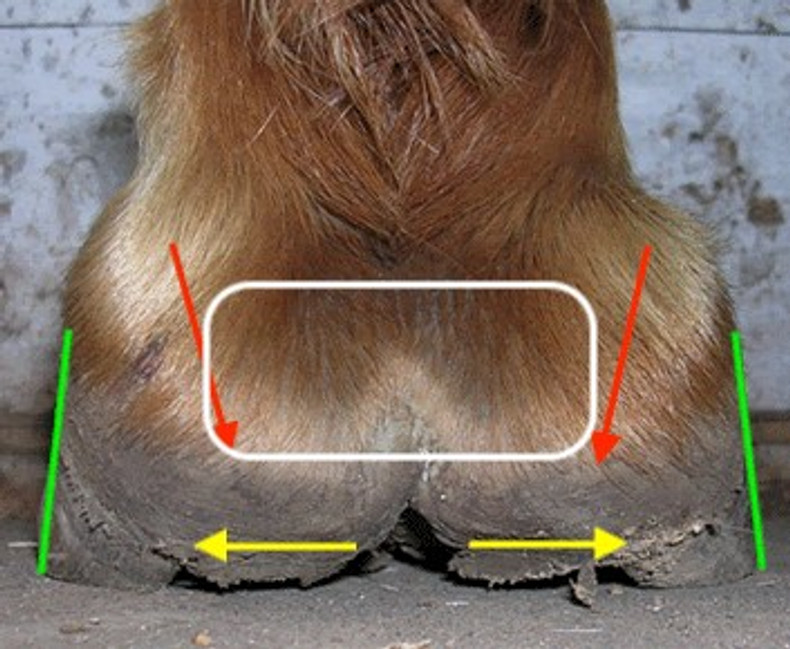What Is The Digital Cushion?
The digital cushion is a wedge-shaped pad composed of fibrocartilage and fat. This elastic cushion is located between the frog, heel bulbs, deep digital flexor tendon (DDFT), and the lateral cartilages above the heel bulbs.

White box - Digital Cushion
Red arrows - Collateral Cartilages
Yellow arrows - Expansion of the soft tissues of
the hoof during landing phase in movement
Green lines - Balanced, healthy heel walls
What Is The Function Of The Digital Cushion?
The digital cushion provides shock absorption and dissipates the energy sent into the hoof from the downward force during the landing phase in movement. When the hoof lands, the digital cushion compresses, and contributes to the expansion of the caudal area (the back half of the hoof). Blood fills vessels and capillaries during this weight bearing phase of the hoof (the caudal region). It also creates a protective barrier for the navicular bone and its bursa, and it supports the DDFT as it stretches and contracts.
Unlike the external hoof capsule, the digital cushion cannot be cut or trimmed into a functional shape. It must grow and develop as a result of proper trimming. The correct living environment, locomotion patterns, and diet all contribute to a healthy digital cushion so that it can withstand the immense amount of force and pressure of the horse’s weight in movement.

The green region is the fibrous tissues of the digital cushion. It reaches beneath the back half of the coffin bone where the (DDFT) is attached. It supports the navicular bone (red circle) and the entire caudal region of the foot. A healthy digital cushion provides a springboard to the horse’s limbs by minimizing effort and contributing to comfortable movement.
Assessing The Health Of The Digital Cushion
Many horses who suffer hoof lameness (and even body soreness) have underdeveloped digital cushions. The caudal foot relies heavily on the shock absorbency and protection from concussive forces that the digital cushion provides. When the caudal foot is weak, underdeveloped, or contracted, you can expect that the digital cushion's strength is directly related. The road to durable, sound hooves is painfully slow unless the caudal area of the foot becomes stronger.
Let’s start by learning if your horse’s digital cushion is healthy or not. There are several clues to help you determine whether your horse has healthy, strong digital cushions or not.
1. Check out your horse’s heels. In the image below, the lateral view of the hoof from the ground level shows heel growth direction. The green lines determine the direction of the tubule growth in the heels, and how this mirrors the internal structures. So, you can see how Hoof “A” has a more developed digital cushion than Hoof “B”.
 |
|
(Image by Paige Poss, Anatomy of the Equine) |
2. Next check out the heel bulbs. You can see below how the heel view of the hoof from the ground level shows the distance between the collateral cartilages, where the digital cushion fills the back of the foot. In a healthy hoof, this area is open with lots of room for a healthy digital cushion.
a) Number 1 is fairly healthy, with the collateral cartilages filled in by the depth of the digital cushion. The central sulcus of the frog is shallow and open as opposed to too deep and contracted.
b) Number 2 has a less than optimal cushion and the heel bulbs appear compressed. These hooves often have a long toe-low heel syndrome.
c) Number 3 has contracted heels and heel bulbs. The collateral cartilages are rigid, and the digital cushion is very weak. (Collateral cartilages are flexible sheets of cartilage on the sides of the hoof that protrude off the back of the coffin bone. In an unhealthy hoof with poor shock absorption, they are prone to calcification, i.e., sidebone.)
 |
| (Image by Paige Poss, Anatomy of the Equine) |
3. Palpation of the digital cushion can also reveal problems. Press your thumb between the collateral cartilages when the hoof is standing on hard ground.
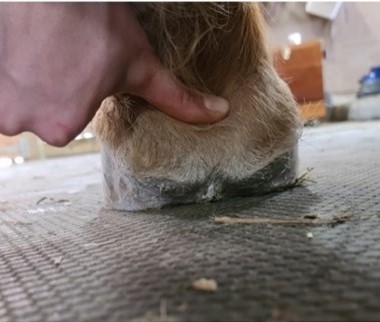

In the #1 image above the digital cushion will feel firm and springy, with no feeling or discomfort to the horse.
In the #2 image the digital cushion might feel spongy, and some horses will pull their foot away to avoid the uncomfortable pressure.
And in the 3rd image palpation will often cause a pain response
How Does Thrush Affect The Digital Cushion?
Thrush is a bacterial infection that infects the tissue of the frog, the collateral grooves, and any flaps, crevices, or holes in the frog or heel bulbs. Thrush infections cause pain and inflammation in the frog making it too painful for the horse to land on. So, the horse will avoid landing heel-first to prevent this pain and discomfort. This results in chronic toe-first landings which cause the digital cushion to weaken because it is unable to maintain optimal strength without normal concussion and expansion.
These three images below are of the same hoof. You can see how the heel overgrows in an effort to unload the tender frog. The heel bulbs are contracted and pressed out behind. The collateral cartilages are rigid which occurs in an effort to support the caudal foot when the digital cushion is underdeveloped. This horse lands toe-first walking down the barn aisle. (The hoof in image number 3 above is in the same situation.)
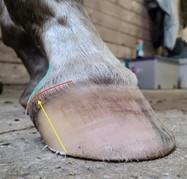


This hoof demonstrates a frog infection and long toes. Do you see any similarities in these images to your horse’s hooves?
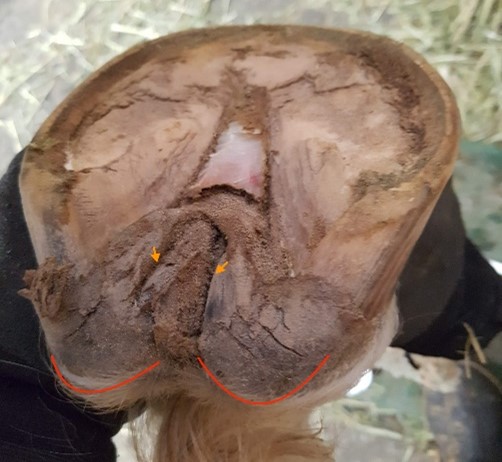
How Do Long Toes Affect The Digital Cushion?
Correct locomotion is essential to developing a healthy digital cushion. Excessive wall length at the toe increases strain on the deep digital flexor tendon (DDFT) and the connective tissues. Excessive toe length also increases the breakover period for the hoof in movement. The extra time taken to pass over the toe as the horse moves forward increases the risk of toe-first landings, as opposed to healthy heel-first landings. Toe first landings cause immense and abnormal concussive forces to the internal structures of the hoof including the coffin bone. If the hooves are shod, these forces are exacerbated by metal shoes which radiate concussion up the limbs.
You can see the images here of excessively long toes.
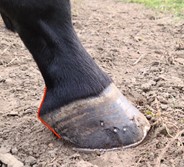


And these images reflect horses who were both struggling with caudal hoof pain but were diagnosed as navicular syndrome. Always get a second opinion.
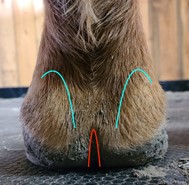

Steps To Building A Healthy Digital Cushion
First learn what a healthy hoof should look like. These hooves have straight wall tubules and well-developed digital cushions. Do you believe the first hoof is a 14-year-old, off the track Thoroughbred? The hoof is an amazing structure which knows how to heal and thrive when the lifestyle, nutrition, and hoof care are optimized.



The correct living environment, locomotion patterns, nutrition, and hoof care all contribute to a healthy digital cushion that will support your horse on any terrain. Here is a list of considerations you can implement to develop durable feet:
1. Maximize life outdoors. Ever heard the term, “Use it or lose it”? Horses who live outside in a herd are continually moving and exercising those internal hoof structures.
2. Appropriate nutrition. Horses grow healthy digital cushions when fed forage-based diets with minimal sugars and supplemented with essential minerals and vitamins. Heavily processed grains and feeds contain ingredients which can cause inflammation inside the hoof and sensitivity to the back of the foot.
3. Hoof Care. A frequent trim schedule of 3-5 weeks ensures the hooves can be balanced without removing too much hoof at one time. Longer trim cycles (over 6 weeks) often create drastic changes to the hoof structures at every trim which directly affect the horse’s comfort. Take your time to assess your horse’s hooves and communicate with your current hoof care provider if you have questions or if you see room for improvement. Remember the hoof is always growing, and therefore can be changed throughout the horse’s life.
4. Anatomically correct movement. This is a topic that deserves its own article, or book! The digital cushion grows when the horse lands heel-first, and it weakens with frequent toe-first landings. You will achieve heel-first landings when you implement the rest of the list. Many horses benefit from the added protection of hoof boots to support healthy locomotion in certain environments or workload. Hoof boots are flexible, allowing the hoof to respond as it does naturally when barefoot.
Ensure that your horse has a balanced trim, and that their hoof is free of pathologies, deformities, and distortions. Too often we get used to bad looking hooves but we can assure you, that good hoof care matters to the horse!
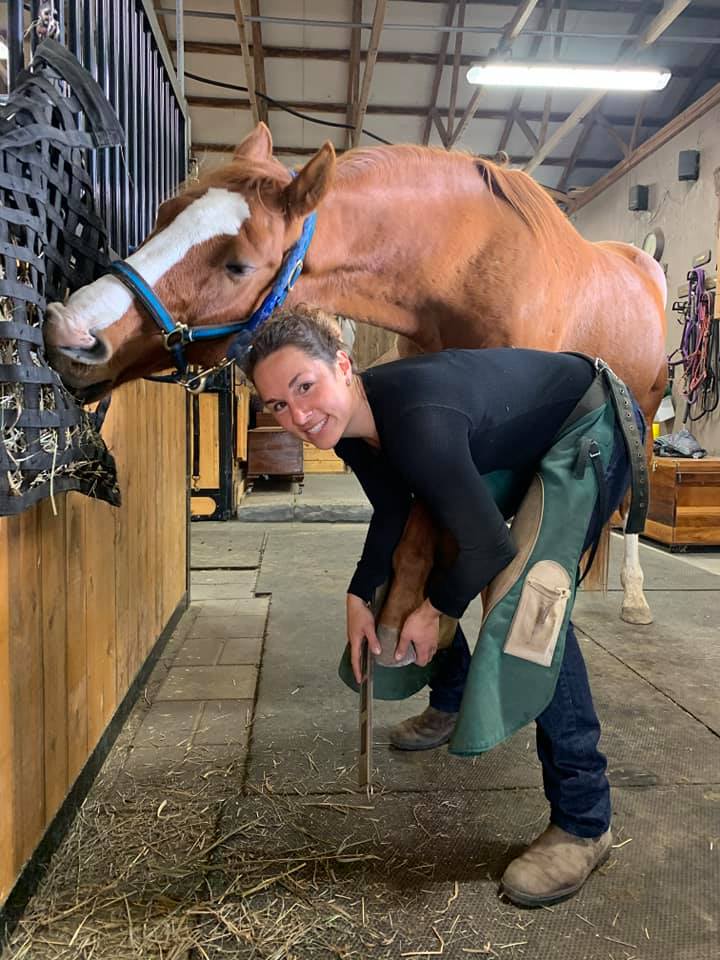
Jessica Fobert is a dedicated and passionate Hoof Care Provider. She is certified with both the American Hoof Association and the Progressive Hoof Care Practitioners group. She is the co-founder of an equine rehabilitation centre located North of Toronto, Ontario where she works with a variety of hoof problems and pathologies. Jessica continues to be inspired by the horses she works with and appreciates how important it is to correct all underlying hoof imbalances. As she says, “the foundation of the entire horse is their hooves!”

